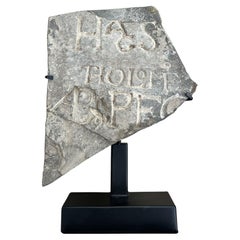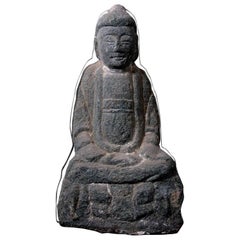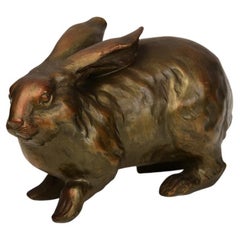Slate Antiquities
to
2
2
2
808
714
551
496
281
1
1
1
1
1
2
2
2
Material: Slate
16th century stone architectural fragment
Located in Vosselaar, BE
A 16th century Spanish slate stone architectural fragment. Probably part of a commerative plaque. The Latin inscription only partly present but most likely being a religious referenc...
Category
16th Century Spanish Medieval Antique Slate Antiquities
Materials
Slate
Biconvex Bronze Age Bactrian stone Idol
Located in Vosselaar, BE
A Bactrian biconvex stone idol. Alongside column and figurative idols these intriguing objects belong to the Bactria-Margana culture. An ancient civilization dating between the 3th a...
Category
15th Century and Earlier Afghan Antique Slate Antiquities
Materials
Slate
Related Items
Shakyamuni, the Original Buddha Sculpted in Schist Stone, Originally from a Cave
Located in San Pedro Garza Garcia, Nuevo Leon
Shakyamuni, the original Buddha sculpted in schist stone. Originally from a cave.
Sui dynasty '589-618' AD
Gautama Buddha, also known as Siddhartha or simply the Buddha. He was an a...
Category
15th Century and Earlier Chinese Antique Slate Antiquities
Materials
Schist
$3,625
H 16 in W 9.5 in D 2 in
20th Century, Showa, Japanese Bronze Animal Rabbit Hollow Sculpture
Located in Sampantawong, TH
Japanese bronze animal rabbit hollow sculpture.
Age: Japan, Showa Period, 20th Century
Size: Height 18.4 C.M. / Width 13 C.M. / Length 30 C...
Category
20th Century Japanese Slate Antiquities
Materials
Bronze
$1,000 Sale Price
20% Off
H 7.25 in W 11.82 in D 5.12 in
15th Century Northern Thai Bronze Buddha Masterpiece w Provenance - 9200
Located in Ukiah, CA
Masterpiece 15th century Northern Thai bronze Buddha. This is the best of the best. Traces of gilding in the crevices of the hair, behind the ears, etcetera. The casting is crisp, the sculpting shows great finesse and depth, the patina is beautiful and complex and desirable, the proportions are classic, and the face as deep and serene and beautiful as any you will find on any Buddha. It is extremely large and is the largest high-end period bronze Buddha from Thailand I have ever had the pleasure of offering at 31 inches tall and in the range of 50 to 60 pounds (most of the clay core scooped out) (Outstanding provenance -from the personal collection of Ali A. Abssi (1934-2020) founder of the Ishtar gate...
Category
15th Century and Earlier Thai Antique Slate Antiquities
Materials
Bronze
$25,000 Sale Price
44% Off
H 31 in W 16 in D 11 in
Ming Dynasty Two Green Glazed Horses and Riders (15-16th Century)
Located in seoul, KR
Statues of Chinese horse riders, featuring glazes in green, are set on rectangular bases.
Period: Ming Dynasty
Medium: Green-glazed Pottery
Typ...
Category
15th Century and Earlier Hong Kong Ming Antique Slate Antiquities
Materials
Pottery
Antique Asian Cast Bronze Horse on Wheels and Tibetan Bell
Located in Plainview, NY
Antique Asian car bronze horse on 4 wheels and a bell featuring Tibetan Buddhist figures. Both pieces show patina on the surface.
Dimensions:
Bell: 7.5...
Category
Late 19th Century Asian Tibetan Antique Slate Antiquities
Materials
Metal
$760 Sale Price / set
20% Off
H 5.5 in W 5 in D 4.5 in
Meiji Era circa 1900 Antique Japanese Bronze Sea Dragon 3-Arm Candelabra
Located in Tustin, CA
Magnificent and powerful, fantastically sculptural, ferocious bronze Japanese writhing sea dragon candleholder is coiled around itself, with an uplifted head and a stylized plume of ...
Category
Late 19th Century Japanese Meiji Antique Slate Antiquities
Materials
Bronze
$1,895
H 16 in W 9 in D 7.5 in
Large Thai Bronze Buddha
Located in Greenwich, CT
Large Thai bronze sitting buddha.
Category
19th Century Thai Other Antique Slate Antiquities
Materials
Bronze
Ming Dynasty Green-Glazed Horse and Rider (15-16th Century)
Located in seoul, KR
Statues of Chinese horse and rider, featuring glazes in green, amber, are set on rectangular bases.
Period: Ming Dynasty
Medium: Green-glaze...
Category
15th Century and Earlier Hong Kong Ming Antique Slate Antiquities
Materials
Pottery
Ming Period Large Pottery Horse with Saddle (15-16th Century)
Located in seoul, KR
The figure stands on a rectangular base. The horse is depicted in a poised stance, with strong, muscular legs and a slightly bowed head. The mane is carefully sculpted with deep, flowing grooves, adding a dynamic texture to the piece. The head features expressive details, including a well-defined muzzle, flared nostrils. The bridle and harness are delicately painted in faded green, contrasting against the creamy beige body. The saddle is adorned with intricate details, including decorative tassels and a textured pattern, indicative of the elaborate tack used in the Ming period.
Traces of original polychrome pigments in green, black, and ochre remain on the surface, hinting at the sculpture’s once-vibrant appearance. The weathered patina and areas of flaking paint add to its historical authenticity, reflecting centuries of age. The overall craftsmanship and detailing exemplify the Ming Dynasty’s refined ceramic artistry, making this piece a remarkable representation of of asian culture during this period.
Period: Ming Dynasty
Medium: Green, black, and ochre glazed Pottery
Type: Figure
Condition : Good(chips on the upper saddle.)
Provenance : Acquired in late 1990s from Hongkong
Reference : Asian Civilisations Museum - Accession No. C-1384 / 1994-00441 - Ming Dynasty Figure of Horse
(Type : Closely Related)
* Ming Dynasty Glazed Pottery Figures
Ming Dynasty glazed pottery figures are renowned for their bold color palette, intricate detailing, and lifelike forms, distinguishing them from earlier traditions. These figures, which depict officials, warriors, animals, and mythical creatures, are characterized by high-gloss lead-based glazes in green, amber, ochre, and sancai (three-color) combinations. The thickly applied glaze pools in recesses, creating depth and enhancing sculptural details. With dynamic postures, expressive facial features, and meticulously rendered drapery, these figures reflect the period’s advancement in ceramic craftsmanship, offering a greater sense of movement and realism compared to the rigid and stylized forms of earlier dynasties.
A defining characteristic of Ming glazed pottery is its elaborate surface detailing, often achieved through raised relief elements and contrasting glazes. Equestrian figures, for example, feature carefully sculpted saddles, harnesses, and decorative embellishments, while human figures are adorned with intricate robes and headdresses. The large scale of these tomb figures, often more imposing than those from previous periods, underscores the increasing importance of funerary art during the Ming era. Unlike later Qing Dynasty figures...
Category
15th Century and Earlier Hong Kong Ming Antique Slate Antiquities
Materials
Pottery
$2,800 Sale Price
30% Off
H 9.45 in Dm 11.82 in
Late 19th Century Bronze Chinese Buddha Sculpture
Located in Catania, Sicilia
An high quality bronze sculpture of Buddha hand-crafted in China in late 19th century. It has normal signs of use and age.
Category
Late 19th Century Chinese Chinese Export Antique Slate Antiquities
Materials
Bronze
Bronze Siamese Asian Buddha Antiquity Hand Sculpture Fragment, 15th-16th Century
Located in Studio City, CA
A wonderful and very special piece.
This bronze buddha hand sculpture, perhaps a fragment of a larger piece at one time, originally came from the prestigious Doris Wiener Gallery ...
Category
16th Century Asian Antique Slate Antiquities
Materials
Bronze
$2,450
H 2.25 in W 5.5 in D 2.25 in
16th Century, Shan, Antique Burmese Bronze Seated Buddha
Located in Sampantawong, TH
Antique Burmese bronze Buddha sitting in Mara Vijaya (calling the earth to witness) posture on a base.
Age: Burma, Shan Period, 16th Century
Size: Height 16.3 C.M. / Width 8.6 C.M.
...
Category
16th Century Burmese Antique Slate Antiquities
Materials
Bronze
$680 Sale Price
20% Off
H 6.42 in W 3.39 in D 1.97 in
Recently Viewed
View AllMore Ways To Browse
Large Chinese Celadon Pots
Khmer Torso
Ancient Luristan Bronze
Chinese Terracotta Army Warriors
Cloisonne Pots Bonsai Trees
Greco Bactrian
Han Dynasty Amphora
Han Dynasty Court Lady
Palanquin Handles
Sancai Phoenix
Schist Gandharan Buddha
Bactrian Stone
Chinese Coconut Cup
Han Dynasty Chinese Cocoon Jar
Han Dynasty Cocoon Jars
Han Dynasty Pig
Khmer Goddess
Kojima Shoten


